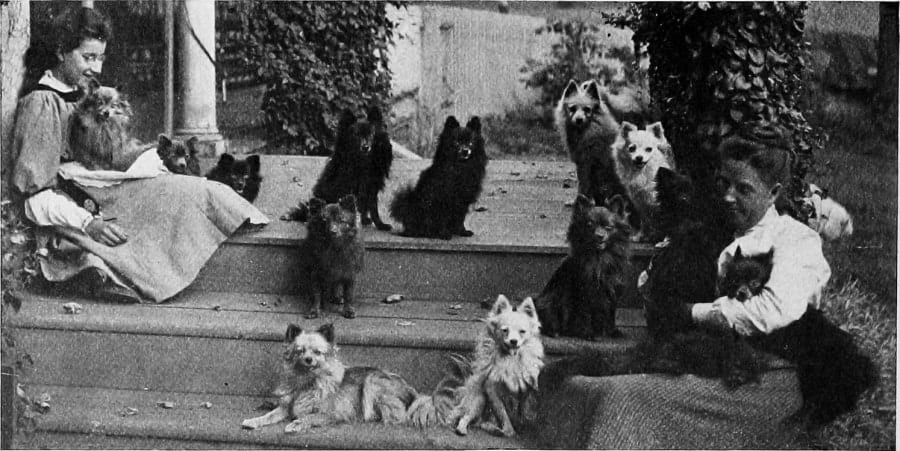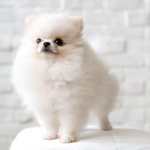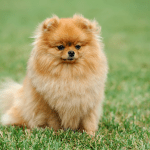From Arctic working dogs to British royalty to survivors of the Titanic, Pomeranians have been all around the world and globally renowned for their beauty and strong character. If you’ve ever owned a Pomeranian or simply been around one, you’ll know they’re one of the most charismatic, energetic, and lovable dogs in the world.
It’s not often for dog breeds to have such a deep and rich history while also being one of the most iconic dog breeds of all time. Pomeranians certainly fit this bill and they show it in their actions every single day.
You might have asked yourself a few times why a Pomeranian looks and acts the way they do. Well, just like any other creature their immutable characteristics were formed over many years. Understanding the modern day Pomeranian requires a deep dive into the origins and history of Pomeranians.
So what are the origins and history of Pomeranians?
The Land of Pomerania
Many, many years ago in a land bordering Germany, Poland, and the Baltic Sea, there was a place called Pomerania. While it’s still sometimes referenced today as a region located in Poland, it’s technically a historical region replaced by the popular Polish city Gdansk. The name Pomerania is a derivation of the Slavic term “po more”, which means “by the sea” or “on the sea”.
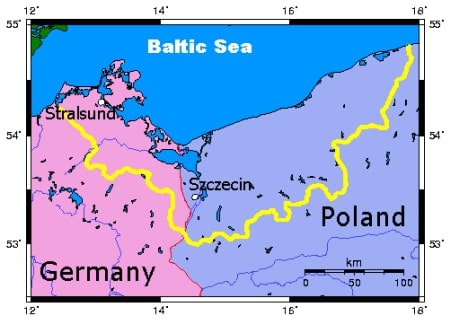
Pomerania was mostly covered by local farms, lakes, forests, and small towns. However, after World War I and II, the region of Pomerania split resulting in population shifts. Today, there are a number of regions in Germany and Poland that hold on to their historical roots of Pomeranian, including places like:
- Hither Pomerania
- The West Pomeranian Voivodeship
- The Pomeranian Voivodeship
- The Kuyavian-Pomeranian Voivodeship
Today, these and other European regions are all considered to be in the Pomeranian region. How cool is that?!
Now that you know the region where Pomeranians got their name from, it’s important to realize that modern-day Pomeranians are much different than what they used to be like. Hundreds of years ago, Pomeranians didn’t exist in the way we know them now, but they do have historical origins tied to some pretty hard working dogs that were often found in Pomerania.
Arctic Work Dogs
Pomeranians come from a long line of Arctic work dogs that were often found in what’s known today as the Pomeranian region in Northern Germany and Poland. It’s hard to imagine our Pomeranians having a genetic link to strong, burly, Arctic working dogs that looked an awful lot like wolves, but it’s absolutely true!
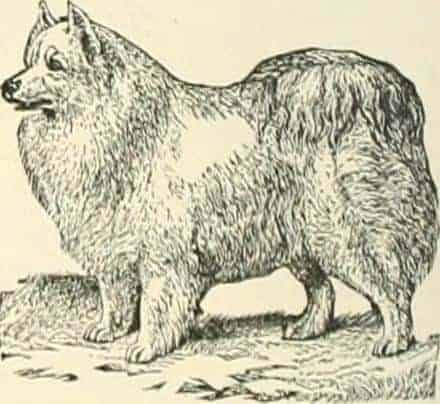
While Pomeranians are considered today as a toy breed amongst dogs, they have a genetic history linked directly to the much larger Wolfspitz or Spitz-type of dog, commonly known today as the German Spitz. In many countries around the world, this breed of dog is often called a Zwergspitz, which is “Dwarf-Spitz” in German.
Being a strong, sturdy, and healthy dog, the German Spitz were large working dogs often found in the Arctic regions of Northern Europe. Their original name was coined by Count Eberhard Zu Sayn in the 16th century as Wolfspitz (“sharp point” in German), which is in reference to their short, pointy nose.
There’s a rumor among experts that the original dog type worldwide is actually the German Spitz! If you take a look at what a German Spitz looks like, you’ll notice they are extremely similar to Pomeranians. Who knows, maybe your Pomeranian has similar genes to the first dogs ever discovered in the world!
As a matter of fact, there are several breed types of the Spitz dog in the world today, including the
- Grossespitz (or Giant Spitz)
- Mittelspitz (or Middle/Standard Spitz)
- Kleinspitz (or Miniature Spitz)
- Wolfspitz (aka Keeshond)
- Zwergspitz (aka Pomeranian)
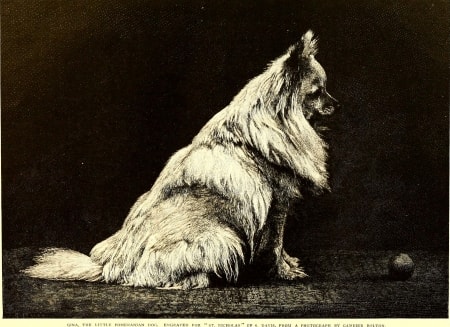
While some breeders consider these types of dogs to be of the same breed, just with different characteristics, others tend to disagree. According to the British Kennel Club and American Kennel Club, only the Kleinspitz, Mittelspitz, Wolfspitz (Keeshond), and Zwergspitz (Pomeranian) are considered as distinct breeds.
It’s often the case that Kleinspitz and Pomeranian dogs are mistaken for one another. However, these types of dogs have been determined to be two distinct breeds, therefore shouldn’t be considered the same breed of dog.
Influence by the British Royal Family
Understanding how we got the Pomeranians we know and love today certainly requires a look at the historical origins of Pomeranians going as far back as the land of Pomeranian. However, the breeds of dogs found that far back only somewhat resemble the modern day Pomeranian.
If we want to get a more in-depth understanding of when the Spitz dog became what we know now as our cuddly little Pomeranians, we need to start by looking at the British royal family.
The evolution of the Pomeranian really started to kick into gear once two of the most prominent members of the British royal family, Queen Charlotte and Queen Victoria, fell in love with these dog breeds. As a matter of fact, the first two Pomeranians ever purchased by Queen Charlotte goes as far back as 1767. That’s a long time ago!

These royal Pomeranians were named Phoebe and Mercury and were still of a size much larger than the Pomeranians we know today. Actually, these two “little” guys weighed somewhere between 30 and 50 pounds (or 14-23 kilograms), which is four to seven times the weight of modern Pomeranians!
Queen Charlotte loved her two Pomeranians so much that she would bring them along when she would be painted by the world-renowned artist Thomas Gainsborough.
Now, Queen Charlotte simply introduced Pomeranians into popularity when she bought Phoebe and Mercury, but never really promoted them or encouraged too much breeding. However, her granddaughter Queen Victoria had fallen so much in love with the Pomeranian breed that she set out to do what no one had done before.
If we truly want to look at the biggest influencer in the breeding of the modern Pomeranian, Queen Victoria is by far the greatest. She absolutely adored Pomeranians and owned more than most would ever see in a lifetime. As an avid Pomeranian enthusiast, she established the worlds largest Pomeranian breeding kennel at the time and turned up the breeding dial to 11.

Queen Victoria had always been a fan of the smaller Pomeranians, so she made it her mission to breed them down to a smaller size over generations of Pomeranians. One of her favorites was named Marco, who had a strong red sable coat and weighed approximately 12 pounds (or 5.4 kilograms).
With her famously small Marco, Queen Victoria featured him around social gatherings and shows alike, which produced popularity like no other. This started a so-called Pomeranian breed revolution resulting in breeders breeding down Pomeranians to similarly small sizes and showcasing them in dog shows around the world.
It’s been said that Queen Victoria had been so influential in the breeding of modern Pomeranians that she helped decrease their size by over 50%! These little guys and gals were so popular that she started to important different breeds of dogs with different colors to produce Pomeranians of a variety of color. That’s actually one of the main reasons Pomeranians have one of, if not the, largest varieties of color amongst all dog breeds.
Among Queen Victorias many achievements regarding Pomeranian breeding, by far her greatest achievement was in popularizing and “marketing” the breed among elites and artists alike. She was known to gift Pomeranians to famous royalty around the world, including the wife of Napolean as well as King George IV.

Soon enough, Pomeranians became rather prolific all across Western cultures and had the first Pomeranian breed club established in 1891. This breed club standardized what made the Pomeranian breed unique compared to other dog breeds. This standard was later adopted in America by the American Kennel Club (AKC) in 1898 and then fully recognized in 1900.
As you can probably tell, Pomeranians became extremely popular all across Europe due to the rise of the breed in England. Thanks to Queen Charlotte and Queen Victoria of the British royal family, the world was gifted what we now know today as the Pomeranian.
Popularity in the USA
While Pomeranians originated in Europe and became widely popular across the continent, they also had a decent following in the USA. For these cuddly little creatures, the history of the Pomeranian isn’t as deep as the Arctic working dog days but surely has grown rather strong over the years.

Of the most popular breeds in the US, Pomeranians consistently rank at the top of the list. They generally rank in the top 20 based on the polls produced by the AKC. I feel like I’ve seen more and more Pomeranians over the years, which is probably due to their popularity in pop-culture thanks to a bunch of celebrities.
Pomeranians started showing up in the US back around the late 1800s when performing in various dog shows. This is about the time when Pomeranians weren’t exactly recognized as a separate dog breed, so were therefore categorized as “Miscellaneous” whenever they participated in official dog shows and the such. As a matter of fact, the first Pomeranian known to have entered the US was in 1892 in New York with the name Sheffield Lad.
Once the number of Pomeranians increased, however, the AKC couldn’t ignore them any longer, so in 1900 they finally recognized the Pomeranian as an official dog breed. Goodbye “Miscellaneous”, hello “Pomeranian”! The most popular colors of Pomeranians at dog shows were white, brown, and blue (kind of like a light, colorful gray).

Following the recognition of the Pomeranian breed in the US, Pomeranians started showing up all across the country to participate in dog shows. Interestingly enough, the very first official Pomeranian breed show in the US took place in New York in 1910. The winner of that competition? A black Pomeranian named Canner Prince Charming.
One of the strange events that involved Pomeranians was when the Titanic sank back in 1912. Sadly, around 1,600 people died and countless pets. While there were many different pets on board, there were 12 dogs, in particular, taking part in the maiden voyage. Of these 12 dogs, only 3 survived: 1 Pekingese and 2 Pomeranians.
One of the Pomeranians was named Lady and was owned by a 24-year-old woman named Margaret Hays who had boarded the Titanic in Cherbourg, France. When the Titanic started to sink, she and her friends dressed and wrapped Lady in blankets before boarding the lifeboats. Apparently, one of the lifeboat passengers made a joke “Oh, I suppose we ought to put a life preserver on the little doggie, too”. Of course!

The other Pomeranian’s name is unknown, but the owners were wealthy clothing business owners Martin and Elizabeth Jane Anne Rothschild. Apparently, the people on the lifeboat didn’t agree that taking the Pomeranian on what was a limited amount of space on the lifeboat. However, she managed to keep her Pomeranian hidden and sneaked it onto the lifeboat.
Pomeranians became so incredibly popular in such a short amount of time, they were even considered good investments. Can you imagine that?! If you owned a Pomeranian in the early 20th century, you could have traded them for large sums of money depending on the purity of the breed, color, size, and more. Unfortunately, this incentivized breeders to resort to mass amounts of Pomeranian inbreeding, resulting in health problems that still linger with Pomeranians to this today.
Historically Famous Pomeranian Owners
Going through the origins and history of Pomeranians is one of the more fascinating topics when discussing this cute and cuddly dog breed. Not only that, many famous people had owned a Pomeranian or two, including royalty. To me, that information is extremely interesting because you don’t often learn that a particular dog breed was an obsession of historically famous people!

Here’s a list of some of the most historically famous people ever who owned Pomeranians.
Queen Charlotte
Without Queen Charlotte, the introduction of the Pomeranian to the rest of the world might have taken longer or never happened at all. If you’re a Pomeranian lover, a lot of thanks needs to go to Queen Charlotte. Her Pomeranians were named Phoebe and Mercury and often accompanied her when she was being painted.
Queen Victoria
If you want to know the most influential person to bring about the modern Pomeranian, Queen Victoria is it. After Queen Charlotte brought Pomeranians into the royal family, Queen Victoria fell in love and started breeding them all the time. Throughout all of this breeding, she ended up producing the kind of Pomeranian we know and love today.
Wolfgang Amadeus Mozart
The world-renowned classical music composer had a Pomeranian named Pimperl and dedicated one of his famous arias after his Pomeranian.
Harry Houdini
Hiding was no problem for Harry Houdini, and sometimes he had to hide his Pomeranian Charlie when crossing international borders. He was gifted Charlie by the Grand Duke of Russia in 1903 and brought him everywhere with him.
Theodore Roosevelt
One of the manliest of US presidents had a Pomeranian named Gem. He ended up having to give his Pomeranian to a family member as a present since he was so busy.
Sir Isaac Newton
The famous mathematician and physicist who discovered gravity had a Pomeranian named Diamond that he kept by his side while working tirelessly. Apparently, Diamond caused a ruckus in Newton’s study after accidentally running into a table leg causing a lit candle to burn up one of his manuscripts! But no one, not even Sir Isaac Newton, can stay mad at a Pomeranian for too long.
Sir Thomas Gainsborough
The famous English portrait and landscape painter Thomas Gainsborough had his very own Pomeranian. As a matter of fact, he’s known to have been bored of constantly painting royal portraits, so he started painting pets and Poms galore! He painted many famous Pomeranians, including Queen Charlotte’s and Carl Friedrich Abel’s.
Carl Friedrich Abel
The remarkable classical music composer Carl Friedrich Abel had a Pomeranian and was known to include it in the portraits that were painted by Gainsborough.
Martin Luther
The well-known German monk, theologian, and church reformer Marin Luther had a Pomeranian named Belferlein.
Frederic Chopin
One of my favorite classical music composers Chopin had a girlfriend that owned a Pomeranian! The saying goes that he saw their Pomeranian running around and chasing his own tale, inspiring to write “Waltz of the Little Dogs” or “Waltz in D Flat, Op. 64, No. 1”. Maybe you’ll recognize the song!
Charles Darwin
Charles Darwin, the famous naturalist, biologist, and geologist, owned a Pomeranian named Snow.
Emile Zola
One of the most famous French novelists, playwrights, and journalists back in the late 19 century owned a Pomeranian.
Marian Kennedy
One of the Kennedys, Marian Kennedy, had a Pomeranian named Pomeria Buttercup.
Elvis Presley
Noone other than Elvis Presley gifted a Pomeranian to his mother so they could bond and enjoy each other’s company toward the end of her life. Once Elvis’s mother passed, Elvis adopted the Pomeranian right away. The Pomeranian’s name was Sweet Pea.
Final Thoughts
It doesn’t take much convincing to know that Pomeranians have come a long way. The Pomeranian breed, compared to several other dog breeds, is fairly recent in history and has since taken the world by storm.
From Arctic work dogs that toiled for their fellow man in the bordering region of Germany, Poland, and the Baltic Sea to impressing the British royal family so much that they popularized Pomeranians across the globe. These cuddly little creatures have had one interesting ride, and have proven to be one of the most famous and beloved dog breeds in the world.

